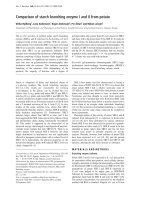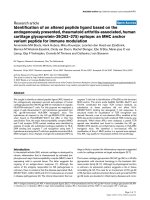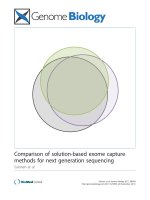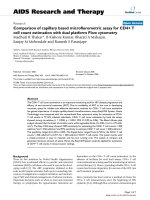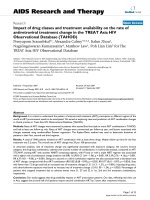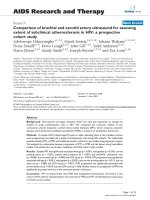Báo cáo y học: " Comparison of the effects of salmeterol/fluticasone propionate with fluticasone propionate on airway physiology in adults with mild persistent asthma" docx
Bạn đang xem bản rút gọn của tài liệu. Xem và tải ngay bản đầy đủ của tài liệu tại đây (278.6 KB, 7 trang )
BioMed Central
Page 1 of 7
(page number not for citation purposes)
Respiratory Research
Open Access
Research
Comparison of the effects of salmeterol/fluticasone propionate with
fluticasone propionate on airway physiology in adults with mild
persistent asthma
Catherine M Houghton*
1,3
, Naomi Lawson
1
, Zoe L Borrill
1,3
,
Claire L Wixon
2
, Sally Yoxall
2
, Stephen J Langley
^1
, Ashley Woodcock
1,3
and
Dave Singh
1,3
Address:
1
North West Lung Research Centre, South Manchester University Hospitals Trust, Manchester, UK,
2
Research and Development,
GlaxoSmithKline, Greenford, Middlesex, UK and
3
Faculty of Medical and Human Sciences, The University of Manchester, Manchester, UK
Email: Catherine M Houghton* - ; Naomi Lawson - ; Zoe L Borrill - ;
Claire L Wixon - ; Sally Yoxall - ; Stephen J Langley - ;
Ashley Woodcock - ; Dave Singh -
* Corresponding author ^ Deceased
Abstract
Background: This study compared the effect of inhaled fluticasone propionate (FP) with the
combination of salmeterol/fluticasone propionate (SFC) on lung function parameters in patients
with mild asthma.
Methods: Adult patients with mild persistent asthma (≥ 80% predicted FEV
1
) receiving 200–500
μg of BDP or equivalent were randomised to receive either FP 100 μg or SFC 50/100 μg twice daily
from a Diskus
®
inhaler for four weeks. The primary outcome was the change from baseline in
airway resistance (sRaw) at 12 hrs post dose measured by whole body plethysmography. Impulse
oscillometry and spirometry were also performed.
Results: A comparison of the geometric mean sRaw at 12 hrs post dose in the SFC group to the
FP group gave a ratio of 0.76 (0.66 – 0.89, p < 0.001) at week 2 and 0.81 (0.71 – 0.94, p = 0.006)
at week 4. Similarly, significant results in favour of SFC for oscillometry measurements of resistance
and reactance were observed. FEV
1
was also significantly superior at week 2 in the SFC group
(mean difference 0.16L, 95% CI; 0.03 – 0.28, p = 0.015), but not at week 4 (mean difference 0.17L,
95% CI -0.01 – 0.34, p = 0.060).
Conclusion: SFC is superior to FP in reducing airway resistance in mild asthmatics with near
normal FEV
1
values. This study provides evidence that changes in pulmonary function in patients
with mild asthma are detected more sensitively by plethysmography compared to spirometry
Trial registration number: NCT00370591.
Published: 14 July 2007
Respiratory Research 2007, 8:52 doi:10.1186/1465-9921-8-52
Received: 15 January 2007
Accepted: 14 July 2007
This article is available from: />© 2007 Houghton et al; licensee BioMed Central Ltd.
This is an Open Access article distributed under the terms of the Creative Commons Attribution License ( />),
which permits unrestricted use, distribution, and reproduction in any medium, provided the original work is properly cited.
Respiratory Research 2007, 8:52 />Page 2 of 7
(page number not for citation purposes)
Background
Clinical trials of drug treatments for asthma commonly
use the spirometric assessment of FEV
1
to assess improve-
ments in lung function. FEV
1
is a relatively simple and
reproducible measurement that is required by regulatory
authorities. However, in patients with mild asthma, FEV
1
may be close to normal and is not as sensitive as body
plethysmography and impulse oscillometry (IOS) for
measuring small changes in lung function in response to
broncodilators [1-3]. Furthermore, body plethysmogra-
phy assesses airway resistance while IOS measures pulmo-
nary resistance and reactance, properties not assessed by
spirometry [3-6].
Combination therapies of inhaled corticosteroids (ICS)
with a long acting beta agonist (LABA) are effective in the
treatment of asthma. The combination of salmeterol and
fluticasone propionate (SFC, Seretide GSK™) improves
symptoms, lung function and exacerbation rates when
compared to the same or double the dose of fluticasone
propionate (FP) in symptomatic patients with asthma
who have moderately impaired lung function (FEV
1
<80%
predicted) [7-9]. However, there are less data regarding
the effects of SFC in symptomatic patients with mild
asthma who may have almost normal FEV
1
values. The
advantages of SFC over ICS alone in this subgroup is dif-
ficult to evaluate using FEV
1
, as this measurement is near
normal. In the absence of studies using more sensitive
pulmonary function measurements than FEV
1
, guidelines
have favoured the use of ICS alone for mild asthma
patients [10]. However, the benefits of combination ther-
apy with SFC in patients with mild asthma may be more
apparent if sensitive pulmonary function measurements,
such as body plethysmography and IOS are used.
We report a comparison of the effects of SFC 50/100 μg
twice daily compared to FP 100 μg bd in patients with
mild asthma already being treated with ICS. Our primary
aim was to compare the changes in lung function,
assessed by plethysmography, IOS and spirometry.
Methods
Study subjects
Patients with physician diagnosed asthma for at least six
months who were receiving a stable total daily dose of ICS
equivalent to 200–500 μg beclomethasone dipropionate
(BDP) for at least 4 weeks prior to the study were enrolled.
The inclusion criteria included an FEV
1
≥ 80% predicted
and demonstration of a ≥ 30% decrease in sRaw in
response to 400 μg of inhaled salbutamol at screening.
This reversibility criterion was based on previous data
demonstrating that this magnitude of change in sRaw was
significantly greater than within day variability [1]. Exclu-
sion criteria were the use of parenteral, oral and nebulised
steroids in the 4 weeks prior to the study or 12 weeks for
depot corticosteroids and current smokers or ex smokers
for < 12 months. All female patients of childbearing
potential were required to be using appropriate contracep-
tion and have a negative pregnancy test results at screen-
ing. All patients gave written informed consent and the
study was approved by the south manchester ethics com-
mittee; reference number 02/SM/460.
Study design and medication
This was a single centre, randomised, double blind, paral-
lel group trial conducted between December 2002 and
April 2004. All patients were treated with FP 100 μg bd
through an Accuhaler/Diskus (GSK™) during a 2 week run
in period. To be eligible for randomisation, subjects were
required to have symptoms more than once a week, but
not every day of the week during the run in period. At the
end of the run in period, baseline measurements of pul-
monary function and methacholine reactivity were per-
formed. Subjects were then randomised to SFC 50/100 μg
bd or FP 100 μg bd via identical Accuhaler devices for a 4
week treatment period (Figure 1). Patients were provided
with a salbutamol Accuhaler for as required use. Pulmo-
nary function measurements were performed after the run
in period (baseline) and after 2 and 4 weeks of treatment.
These were performed in the morning before dosing with
study medication (pre-dose), and at 2 hrs post-dose. No IOS
data was collected at week 2. Methacholine reactivity was
assessed 2 hrs post-dose at week 4. Patients were given
diary cards in which to record morning and evening peak
expiratory flow (PEF).
Pulmonary function and methacholine challenge tests
Pulmonary function tests were always performed in the
same order: (1) IOS, (2) plethysmography and (3)
spirometry. The deep inspiration required for spirometry
may cause a temporary alteration in bronchial tone [11]
Study flow chartFigure 1
Study flow chart.
Visit 1
- 14 days
Visit 2
-1 day
Visit 3
day 0
Visit 4
day 14
Week 2
Visit 5
day 28
Week 4
Run – in
FP 100mcg bd
Treatment period
SFC 50/100mcg or FP100mcg bd
Follow up
day 35
Usual
treatment
Respiratory Research 2007, 8:52 />Page 3 of 7
(page number not for citation purposes)
so resistance measures were made prior to spirometry. A
full explanation and training in the performance of each
lung function test was given to each subject prior to the
study.
For IOS (Masterscreen IOS, Erich Jaeger, Hoechberg, Ger-
many) subjects supported their cheeks to reduce upper
airway shunting while impulses were applied during tidal
breathing for 30 seconds. The mean of three readings of
R5 and R20 (respiratory resistance at 5 and 20 Hz respec-
tively), X5 (reactance at 5 Hz) and RF (resonant fre-
quency) were recorded. For plethysmography, sRaw and
sGaw were measured in a constant volume plethysmo-
graph (Sensormedics Vmax 6200) and the mean of 3 read-
ings was recorded. For spirometry, FEV
1
(volume expired
over the first second) and MMEF (maximal mid expiratory
flow rate) were performed (Masterscreen, Erich Jaeger)
and the mean of 3 readings was recorded.
Methacholine challenge tests were performed as previ-
ously reported [12]. A De Vilbiss 646 nebulizer (Sunrise
Medical; Wollaston, UK) and a Rosenthal dosimeter (PDS
Research UK; Gravesend, UK) were used to deliver the
methacholine. Three concentrations of methacholine
chloride were used (1.5 mg/ml, 12 mg/ml and 50 mg/ml,
Stockport Pharmaceuticals, UK) to administer doubling
doses, starting from a dose of 0.015 mg increasing to a
final cumulative dose of 5.96 mg. The PD
20
was calculated
as thecumulative dose that produced a 20% decrease in
FEV
1
by interpolation.
Statistical analysis
The primary outcome measure was the morning pre-dose
sRaw after 4 weeks treatment with SFC and FP. Based on
previous studies a 20% difference in pre dose sRaw
between the two treatment groups was identified as a clin-
ically relevant difference [13]. A sample size of 18 evalua-
ble subjects per group (36 evaluable subjects in total)
would have 90% power to detect a difference of 20%
between treatment groups in pre-study medication sRaw
at 4 weeks of treatment, assuming a common standard
deviation of 0.20 s.kPa of natural log sRaw, at a 5% two-
sided significance level. A sample size of 20 subjects per
group would allow for an estimated treatment withdrawal
rate of 10%.
The differences between the effects of SFC and FP on pul-
monary function measurements and methacholine reac-
tivity were analysed by ANCOVA with covariates of age,
gender, baseline measurement and treatment group. sRaw
and sGaw were log transformed and least square means
for the treatments were transformed back to the original
scale and are presented as geometric means. Baseline PEF
was defined as the mean of the daily values over the last 7
days of the 2 week run in period. Mean morning and
evening PEF were calculated from all the available data
from week 1 to 4. Statistical analysis was performed on an
Intention To Treat basis with all subjects randomised to
treatment being included. If there was no data for the pri-
mary endpoint (sRaw) at week 4, the last observation
from week 2 was carried forward. For analysis of bronchial
hyperreactivity, only subjects who had a 20% decrease in
FEV
1
before or at the highest methacholine concentration
at the end of the run in period and at week 4 (i.e. those
with PD
20
≤ 5.96 mg) were included.
Results
Fifty six patients were enrolled into the run in period, of
which 13 did not meet the daily symptom score require-
ment, 3 did not complete the diary card correctly and 1
was non compliant with run in medication. The demogra-
phy and lung function at screening (before run in) of the
remaining 39 subjects who were eligible for randomisa-
tion is shown in Table 1. Baseline measurements of pul-
monary function after the run in are shown in Table 2.
There were 2 withdrawals following randomisation, one
in each treatment group due to loss of study medication
in he SFC group and medication running out in the FP
group.
Pre-dose pulmonary function
Plethysmography
SFC caused a significantly greater reduction in pre dose
sRaw compared with FP at weeks 2 and 4 (Figure 2 shows
adjusted body plethysmography data). The geometric
mean pre dose sRaw was 24% lower in the SFC group
compared with the FP group (ratio 0.76, 95% CI; 0.66–
0.89, p <0.001) at week 2 and 19% lower (ratio 0.81, 95%
CI; 0.71–0.94, p = 0.006) at week 4. Similarly, there was a
statistically significant greater increase in pre dose sGaw at
week 2 and 4 in the patients receiving SFC compared with
Table 1: Subject demographics at screening
SFC 50/100
N = 19
FP 100
N = 20
Age 38.4 (9.8) 41.8 (14.7)
Sex
1
Female 10 (53%) 12 (60%)
Male 9 (47%) 8 (40%)
Duration of asthma ≥ 15 years 11 (58%) 7 (35%)
% predicted FEV
1
93.4 (9.0) 95.3 (11.4)
FEV
1
3.22 (0.55) 3.04 (0.81)
sRaw s.kPa* 1.00 (39.61) 0.94 (50.28)
sGaw s
-1
kPa 1.29 (152.11) 1.07 (50.47)
% change in sRaw post 400 μg
salbutamol
-43.6 (10.2) -38.4 (7.0)
Data is mean (SD) except;
* = geometric mean (CV)
1
= number of subjects (percent)
Respiratory Research 2007, 8:52 />Page 4 of 7
(page number not for citation purposes)
those receiving FP (Figure 2). sGaw was 30% greater at
week 2 (ratio 1.31, 95% CI; 1.13–1.51, p < 0.001) and
24% greater at week 4 (ratio 1.24, 95% CI: 1.08–1.44, p =
0.004) in the SFC group.
Spirometry
At week 2 there was a small increase in the pre-dose FEV
1
with SFC, that was statistically significant compared with
FP; mean difference 0.16L, 95% CI; 0.03–0.28, p = 0.015
(Figure 3 shows adjusted FEV1 data). The mean difference
at week 4 was 0.17L, which approached statistical signifi-
cance (95% CI -0.01–0.34, p = 0.06). There were no sig-
nificant differences in MMEF measurements between SFC
and FP at week 2 (mean difference 1.1L/sec, 95% CI; -
0.13–2.32, p = 0.08) and week 4 (mean difference 0.11 L/
sec, 95% CI; -0.35 – 0.56, p = 0.6).
Impulse Oscillometry
At week 4 there were statistically significant improve-
ments in IOS measurements in the SFC group compared
with FP (Figure 4 shows adjusted IOS data). The mean RF
at week 4 was 13.07 Hz (95% CI; 11.3 – 14.84) in the SFC
group and 17.65 (95% CI; 15.99 – 19.3) in the FP group.
The mean difference in the resistance parameters R5 and
R20 were -0.11 kPaL
-1
.s (95% CI; -0.16 – -0.06, p < 0.001)
and -0.06 kPaL
-1
·s (95% CI; -0.09–0.02, p = 0.001)
respectively. The mean difference in the reactance param-
eters RF and X5 were -4.58 Hz (95% CI; -7.01– -2.15, p <
0.001) and -0.04 kPaL
-1
·s (95% CI; -0.07 – -0.01, p =
0.019).
Post-dose Pulmonary Function
The improvement in lung function at 2 hrs after the first
dose was greater in the SFC compared with the FP group;
for the primary endpoint of sRaw the adjusted mean
changes between pre and post dose were 36.4 % and 7.1
% respectively. The adjusted mean (95% CI) difference
was 29.3% (20.7 to 37.9), p < 0.001. Pulmonary function
measurements at 2 hrs post dose were stable over the
treatment period, with data in both groups after 2 and 4
weeks dosing similar to measurements after the first dose
(Table 3).
PEF
The mean morning and evening PEF analysed over weeks
1 to 4 was significantly greater (21.6 L/min 95% CI; 10.6
– 32.7, p < 0.001 and 17.6 L/min, 95% CI; 5.1 – 30.2, p =
0.007) in the SFC group compared with the FP group.
Airway hyperreactivity
Twelve subjects in the SFC group and 16 in the FP group
had PD
20
≤ 5.96 mg at the end of the run in period and at
Comparison of FEV
1
between SFC and FP groupsFigure 3
Comparison of FEV
1
between SFC and FP groups. Data
points = adjusted mean change at week 2 and 4 (ANCOVA
adjusted for effects of gender age and baseline lung function).
Error bars = 95% confidence intervals
FP
FEV1 L/sec
Week 2 Week 4
SFC
3
3.1
3.2
3.3
3.4
3.5
Table 2: Baseline (week 0) pulmonary function
SFC 50/100
N = 19
FP 100
N = 20
sRaw s.kPa * 0.86 (42.0)) 0.91 (42.15)
sGaw s
-1
kPa
-1
* 1.17 (42.10) 1.11 (41.91)
FEV
1
(L) 3.24 (0.57) 3.10 (0.75)
MMEF (L.s
-1
) 2.00 (1.45) 2.44 (1.03)
AM PEFR (L/min) 484.02 (105.38) 467.50 (117.64)
PM PEFR (L/min) 494.05 (101.27) 475.52 (112.54)
R5 (kPa.L
-1
.s) 0.44 (0.10) 0.51 (0.15)
R20 (kPa.L
-1
.s) 0.36 (0.08) 0.39 (0.11)
X5 (kPa.L
-1
.s) 0.14 (0.04) 0.17 (0.1)
RF (Hz) 15.29 (4.84) 16.67 (6.35)
AHR (mg) * 0.41 (348.8) 0.37 (372.7)
Data is mean (SD) except;
* = geometric mean (CV)
Comparison of sRaw and sGaw between SFC and FP groupsFigure 2
Comparison of sRaw and sGaw between SFC and FP groups.
Data points = adjusted geometric mean at week 2 and 4
(ANCOVA adjusted for effects of gender age and baseline
lung function). Error bars = 95% confidence intervals
FP
SFC
sRaw s.kPa
Week 2 Week 4
0.5
0.6
0.7
0.8
0.9
1
FP
Week 2 Week 4
SFC
sGaw s
-1
kPa
-1
1
1.2
1.4
1.6
1.8
Respiratory Research 2007, 8:52 />Page 5 of 7
(page number not for citation purposes)
week 4. In these subjects, the ratio (SFC/FP) of the
adjusted means for PD
20
at week 4 was 1.57 (95% CI:
0.70, 3.54), with no difference between groups (p = 0.25).
Discussion
We have studied patients with mild persistent asthma
who are symptomatic despite being treated with ICS.
Asthma guidelines advocate a step wise approach to phar-
macological therapy in such patients, with the aim of opti-
mizing asthma control defined by a range of clinical
endpoints, including symptoms, exacerbation rates and
pulmonary function. One possible step wise approach is
the use of combined LABA and ICS in these patients. This
is the first study to investigate the benefits on airway pat-
ency of combination therapy with SFC (50/100 μg bd)
compared with ICS (FP 100 μg bd) alone in a group of
mild asthma patients.
Our primary endpoint was the sensitive measurement of
sRaw using body plethysmography. The key findings were
that SFC caused significant improvements in sRaw, sGaw
and IOS resistance and reactance parameters at 12 hours
post dose after 2 and 4 weeks treatment. At 2 weeks, a
small but statistically significant difference was observed
using FEV
1
, but not at 4 weeks. In this population of mild
asthma patients, selected for reversibility using criteria
based on sRaw, we have therefore shown that SFC 50/100
μg has greater benefits on pulmonary function compared
with FP 100 μg, which are most apparent when using
more sensitive methods than spirometry. Further studies
are needed to determine if these pulmonary function find-
ings are true in other asthma populations, and whether
overall asthma control is improved by such a strategy.
In order to optimise asthma control in symptomatic mild
asthma patients being treated with low dose ICS, it is pos-
sible to increase the ICS dose or add in a LABA. Using the
SFC combination, we have proved that the addition of
LABA has pulmonary function benefits compared to the
same dose of ICS alone in this particular population. It
would now be important to compare SFC to an increased
dose of ICS alone in this population, as these are the 2
treatment options available in clinical practice.
The bronchodilator profile of salmeterol in asthma is well
established, with maximal effects observed within 1–2 hrs
[13,14]. In this study using SFC, it was therefore relevant
to study both the maximal effects (at 2 hrs post dose) as
well as the effects at 12 hrs post dose, immediately prior
to the next scheduled dose. We chose 12 hrs for the pri-
mary endpoint (sRaw) measurement, as this is the time
point when the effects of SFC are most likely to be similar
to FP. Thus, any superiority of SFC over FP at 12 hrs would
indicate that the benefits of SFC are sustained over the full
12 hrs, and not just confined to the first 2 hrs post dose.
Table 3: Lung function 2 hours post dose
SFC
mean (95% CI)
FP
mean (95% CI)
sRaw s.kPa Week 0 0.53
(0.46, 0.62)
0.84
(0.73, 0.98)
Week 2 0.56
(0.47, 0.67)
0.85
(0.72, 1.01)
Week 4 0.56
(0.48, 0.67)
0.77
(0.65, 0.91)
sGaw s
-1
kPa
-1
Week 0 1.88
(1.61, 2.21)
1.19
(1.02, 1.39)
Week 2 1.80
(1.51, 2.14)
1.18
(1.00, 1.39)
Week 4 1.78
(1.50, 2.12)
1.3
(1.10, 1.54)
FEV
1
(L) Week 0 3.50
(3.16, 3.84)
3.15
(2.82, 3.48)
Week 2 3.41
(3.08, 3.73)
3.07
(2.76, 3.38)
Week 4 3.36
(3.02, 3.70)
3.05
(2.72, 3.38)
Comparison of R5, R20 and X5 between SFC and FP groupsFigure 4
Comparison of R5, R20 and X5 between SFC and FP groups.
Data points = adjusted geometric mean at week 4
(ANCOVA adjusted for effects of gender age and baseline
lung function). Squares = FP. Diamonds = SFC. Error bars =
95% confidence intervals
0
0.1
0.2
0.3
0.4
0.5
0.6
kPaL
-1
.s
R5
R20 X5
SFC
FP
SFC
FP
SFC
FP
Respiratory Research 2007, 8:52 />Page 6 of 7
(page number not for citation purposes)
Although FEV
1
is the "gold standard" of clinical trials, we
observed that substantial improvements in airway resist-
ance occurred in mild asthmatics without a statistically
significant change in FEV
1
after 4 weeks treatment. We
have previously shown that body plethysmography is a
sensitive measurement of bronchodilation in mild asth-
matics i.e. although body plethysmography has increased
variability compared to FEV
1
, it is also more sensitive to
changes in airway tone, and so was able to detect changes
caused by 10 μg salbutamol while there was no change in
FEV
1
[1]. The current study provides further evidence that
changes in pulmonary function in patients with mild
asthma are detected more sensitively by plethysmography
compared to spirometry [1,2].
We did not measure FEV1 reversibility at screening. In the
SFC group, there was an improvement in pulmonary func-
tion of 260 mls after the first dose, equivalent to 8%
reversibility. A higher degree of FEV1 reversibility would
not be expected, as the baseline FEV1 was approximately
94% predicted.
Body plethysmography is more time consuming com-
pared to spirometry, and is a more complex technique
that requires a greater degree of operator training. How-
ever, it is clear that body plethysmography offers advan-
tages in terms of sensitivity and we encourage its use in
clinical trials of mild asthmatics [1-3,15]. The demonstra-
tion of improvements in airway resistance in patients with
mild asthma is important, because it suggests that even in
the context of minimal evidence of lung function impair-
ment using spirometry, there is significant reversible dis-
ease activity that can be detected by measures of lung
function that are more sensitive than those routinely used
in clinical practice.
Involvement of the small airways, even in patients with
mild asthma is increasingly recognised [16]. Improved
deposition of inhaled corticosteroid in the small airways
may lead to a clinical benefit by reducing the persistent
inflammation seen in these airways [16]. It has been sug-
gested that combination therapy may result in enhanced
delivery of inhaled corticosteroid to the peripheral air-
ways [17]. Furthermore LABA's may have a direct bron-
chodilator effect in the small airways [17]. Frequency
dependant changes in resistance and compliance have
been demonstrated in small airway disease [18,19]. It has
been suggested that oscillometry is a sensitive measure of
small airway dysfunction as a range of frequencies are
employed and changes in R5, X5 and RF may reflect small
airway physiology [20-22]. Thus, the changes in IOS dem-
onstrated in this study may indicate beneficial small air-
way effects of SFC. There was no improvement in the
spirometric measurement of MMEF, which has also been
suggested to be an indicator of small airway function. This
is likely to be due to the increased variability of MMEF
compared to IOS causing reduced sensitivity [1]. The use
of IOS is increasing in clinical practice, and the current
study shows a valuable application of this method for
detecting subtle but important effects of drugs that cannot
be measured by standard spirometry.
This study produced some additional findings concerning
the use of combination therapy. We found that post dose
pulmonary function measurements were stable for 4
weeks in both groups. There have been some concerns
about desensitisation to the effects of long-acting beta
2
agonists after prolonged treatment [23]. However, long-
term studies up to 12 months duration have shown no
evidence of tachyphylaxis or tolerance to the bronchodila-
tor effects of salmeterol [24,25]. The current study also did
not observe desensitisation, as 2 hr post dose lung func-
tion measurements in mild asthmatics treated with SFC
were stable over a 4 week period.
There was a trend to an improvement in airway hyper
reactivity (AHR) from baseline in the SFC treatment group
but this was not significant. The current study did not
enrol patients based on an inclusion criterion of AHR, and
was not statistically powered to evaluate changes in AHR,
as AHR was a secondary endpoint. Further studies pow-
ered to assess AHR as a primary endpoint are required to
assess any potential benefit of SFC compared to FP alone
on AHR in this patient population. However, a recent
study has shown in mild to moderate patients that SFC
improved AHR to a significantly greater extent than FP or
salmeterol alone [26].
Conclusion
It is recognised that a substantial number of patients have
mild persistent asthma associated with significant mor-
bidity [27,28]. We have clearly shown that SFC has bene-
ficial effects on lung function in patients with mild
asthma that are not observed with ICS alone. These bene-
fits of SFC therapy were sensitively demonstrated by body
plethysmography and IOS. Further long term studies in
mild asthma are required to ascertain the relationship
between the improvements in lung function observed in
the current study using SFC and clinical parameters such
as symptoms and exacerbation rates.
Competing interests
Catherine Houghton has received travel grants from Glax-
oSmithKline (GSK) and Astra Zeneca (AZ) and support
for a conference from Chiesi. Naomi Lawson has no
financial conflict of interest to declare. Zoe Borrill has
received travel grants from GlaxoSmithKline (GSK) and
support for a conference from Chiesi. Claire Wixon and
Sally Yoxall are employees of GSK the manufacturer of
SFC. Ashley Woodcock has received consultancy fees from
Publish with BioMed Central and every
scientist can read your work free of charge
"BioMed Central will be the most significant development for
disseminating the results of biomedical research in our lifetime."
Sir Paul Nurse, Cancer Research UK
Your research papers will be:
available free of charge to the entire biomedical community
peer reviewed and published immediately upon acceptance
cited in PubMed and archived on PubMed Central
yours — you keep the copyright
Submit your manuscript here:
/>BioMedcentral
Respiratory Research 2007, 8:52 />Page 7 of 7
(page number not for citation purposes)
GSK, Chiesi, Novartis, Schering Plough and Oriel Pharma-
ceuticals, research grants from GSK, Chiesi and Schering
and support for conference attendance from GSK. Dave
Singh has received lecture fees from AZ,GSK and Merck
Sharp Dome, research grants fromGSK and AZ andsup-
port for conference attendance from Boehringer and AZ.
Authors' contributions
All authors participated in the study design, CMH, NL and
ZB coordinated the study and collected the data. SY per-
formed the statistical analysis. CMH, CW, SY, DS and
AAW analysed and interpreted the data. CMH drafted the
manuscript and all authors read and approved the final
manuscript.
Acknowledgements
This study was funded by Glaxo Smith Kline. GSK performed the statistical
analysis and were involved in the study design, interpretation of the data
and the decision to submit the paper for publication.
References
1. Houghton CM, Woodcock AA, Singh D: A comparison of lung
function methods for assessing dose-response effects of salb-
utamol. Br J Clin Pharmacol 2004, 58:134-141.
2. Houghton CM, Woodcock AA, Singh D: A comparison of plethys-
mography, spirometry and oscillometry for assessing the
pulmonary effects of inhaled ipratropium bromide in healthy
subjects and patients with asthma. Br J Clin Pharmacol 2005,
59:152-159.
3. Tattersfield AE, Keeping IM: Assessing change in airway calibre
– measurement of airway resistance. Br J Clin Pharmacol 1979,
8:307-319.
4. Goldman MD: Clinical application of forced oscillation. Pulm
Pharmacol Ther 2001, 14:341-350.
5. Pride NB: Forced oscillation techniques for measuring
mechanical properties of the respiratory system. Thorax 1992,
47:317-320.
6. Hellinckx J, Cauberghs M, de Boeck K, Demedts M: Evaluation of
impulse oscillation system: comparison with forced oscilla-
tion technique and body plethysmography. Eur Respir J 2001,
18:564-570.
7. van Noord JA, Schreurs AJ, Mol SJ, Mulder PG: Addition of salme-
terol versus doubling the dose of fluticasone propionate in
patients with mild to moderate asthma. Thorax 1999,
54:207-212.
8. Ind PW, Dal Negro R, Colman NC, Fletcher CP, Browning D, James
MH: Addition of salmeterol to fluticasone propionate treat-
ment in moderate to severe asthma. Respir Med 2003,
97:555-562.
9. Matz J, Emmett A, Rickard K, Kalberg C: Addition of salmeterol to
low-dose fluticasone versus higher-dose fluticasone: An anal-
ysis of asthma exacerbations. J Allergy Clin Immunol 2001,
107(Suppl 5):783-789.
10. Global Initiative for Asthma (GINA): Global strategy for asthma
management and prevention. In NHLBI Workshop Report
National Institutes for Health National Heart, Lung and Blood Insti-
tute; 2002. NIH Publication Number 02-3659.
11. Pellegrino R, Sterk PJ, Sont JK, Brusasco V: Assessing the effect of
deep inhalation on airway calibre: a novel approach to lung
function in bronchial asthma and COPD. Eur Respir J 1998,
12:1219-1227.
12. Langley SJ, Holden J, Derham A, Hedgeland P, Sharma RK, Woodcock
A: Fluticasone propionate via the Diskhaler or hydrofluoroal-
kane-134a metered-dose inhaler on methacholine-induced
airway hyperresponsiveness. Chest 2002, 122:806-811.
13. van Noord JA, Smeets JJ, Raaijimaker JAM, Bommer AM, Maesen FP:
Salmeterol versus formoterol in patients with moderately
severe asthma: onset and duration of action. Eur Respir J 1996,
9:1684-1688.
14. Palmqvist M, Perrson G, Lazer L, Rosenborg J, Larsson P, Lotvall J: In
haled dry-powder formoterol and salmeterol in asthmatic
patients: onset of action, duration of effect and potency. Eur
Respir J 1997, 10:2484-2489.
15. Van Noord JA, Smeets J, Clement J, van de Woestijne KP, Demedts
M: Assessment of reversibility of airflow obstruction. Am J
Respir Crit Care Med 1994, 150:551-554.
16. Martin RJ: Therapeutic significance of distal airway inflamma-
tion in asthma. J Allergy Clin Immunol 2002, 109(Suppl
2):S447-S460.
17. Currie GP, Stenback S, Lipworth BJ: Effects of fluticasone vs. flu-
ticasone/salmeterol on airway calibre and airway hyperre-
sponsiveness in mild persistent asthma. Br J Clin Pharmacol
2003, 56:11-17.
18. Mead J: Contribution of compliance of airways to frequency-
dependent behaviour of lungs. J Appl Physiol 1969, 26:670-3.
19. De La Hoz RE, Berger KI, Klugh TT, Friedman-Jimenez G, Goldring
RM: Frequency depndance of compliance in the evaluation of
patients with unexplained respiratory symptoms. Respir Med
2000, 94:221-7.
20. van Noord JA, Clement J, van de Woestijne KP, Demedts M: Total
respiratory resistance and reactance in patients with
asthma, chronic bronchitis, and emphysema. Am RevRespir Dis
1991, 143(5 Pt 1):
922-927.
21. Bouaziz N, Beyaert C, Gauthier R, Monin P, Peslin R, Marchal F: Res-
piratory system reactance as an indicator of the intratho-
racic airway response to methacholine in children. Pediatr
pulmonol 1996, 22:7-13.
22. Skloot G, Goldman M, Fishler D, Goldman C, Schechter C, Levin S,
Teirstein A: Respiratory assessment and physiological symp-
toms of ironworkers at the world trade center disaster site.
Chest 2004, 125:1248-55.
23. Cheung D, Timmers MC, Zwiderman AH, Bel EH, Dijkman JH, Sterk
PJ: Long-term effects of a long-acting beta2-adrenoceptor
agonist, salmeterol, on airway hyperresponsiveness in
patients with mild asthma. N Engl J Med 1992, 327:1198-1203.
24. Britton MG, Earnshaw JS, Palmer JBD: A twelve month compari-
son of salmeterol and salbutamol in asthmatic patients. Eur
Respir J 1992, 5:1062-67.
25. Lundback B, Rawlinson DW, Palmer JBD: Twelve month compar-
ison of salmeterol with salbutamol as dry powder formula-
tions in asthmatic patients. Thorax 1993, 48:148-53.
26. Lundback B, Ronmark E, Lindberg A, Jonsson AC, Levsson LG, Petavy
F, James M: Control of mild to moderate asthma over 1-year
with the combination of salmeterol and fluticasone propion-
ate. Respir Med 2006, 100:2-10.
27. O'Byrne PM, Barnes PJ, Rodriguez-Roisin R, Runnerstrom E, Sand-
strom T, Svensson K, Tatteresfield A: Low dose inhaled budeso-
nide and formoterol in mild persistent asthma: the OPTIMA
randomized trial. Am J Respir Crit Care Med 2001, 164:1392-1397.
28. Zeiger RS, Bird SR, Kaplan MS, Pearlman DS, Schatz M, Bird S, Hustad
C, Edelman J: Short-term and long-term asthma control in
patients with mild persistent asthma receiving montelukast
or fluticasone: a randomized controlled trial. Am J Med 2005,
118:649-647.

